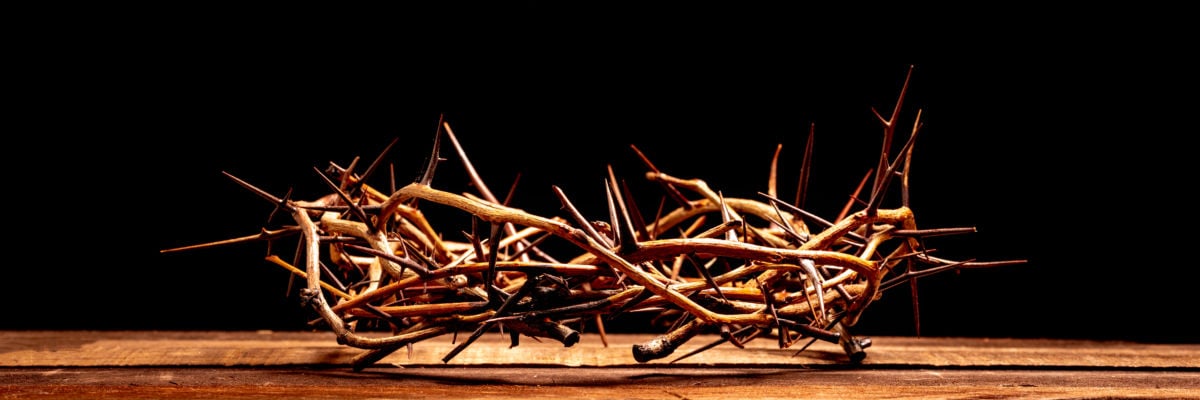
One of the markers of the utter desolation of the Chosen People at certain points of their history was the cessation of the daily sacrifice in the Temple: when Solomon’s Temple was destroyed by the Babylonians, when its replacement was defiled by the Seleucid Empire in the time of the Maccabees, and finally when it was destroyed by the Romans in A.D. 70. The profound grief of these moments found expression in the biblical book of Jeremiah’s Lamentations.
A similar note of grief afflicts the Church in contemplating the crucifixion and death of Our Lord Jesus Christ, commemorated most solemnly on Good Friday. The Lamentations form a major element in the traditional services of Matins and Lauds celebrated over the Triduum, called Tenebrae.
We know that the story does not end there: Jesus rose again. Nevertheless, his death was real, and the grief of his mother and disciples was real. The grief of Our Lady was not based on a misunderstanding or a failure to accept God’s will. It was natural, and it was demanded by the occasion: the suffering and death of her Son. The sorrowful stage of the journey was a necessary one: Christ had to suffer through it, and Our Lady, our model, kept him company in that suffering. We must not succumb to the temptation of flipping the pages of the story too quickly to get to the happy ending.
It is for this reason that the devotion of the stations of the cross takes us to the tomb and leaves us there: not out of mawkishness, but in solidarity with Our Lady’s grief, and indeed all the suffering of the world—suffering that Christ has taken on and redeemed.
The liturgy of Good Friday is therefore one of mourning. Uniquely in the Church’s calendar, the sacrifice of the Mass does not take place. The Church’s desolation is even marked visually, by the stripping of the altars, in which the candlesticks and altar clothes are removed at the end of the Mass of Maundy Thursday. In the pre-Vatican II liturgy of Good Friday, the clergy wear black, and the candles on the altar are unbleached—they are yellow, not white, as for funerals. The service that takes place, once called the Mass of the Pre-Sanctified, does not include the Canon or Eucharistic Prayer, and so it makes use of the consecrated host that was reserved at the altar of repose after the Maundy Thursday Mass.
The terminology of the Mass of the Pre-Sanctified, and the prayers it contained, such as the old offertory prayers, making reference to sacrifice, seemed to create a theological problem. This led to a reform of the rites in 1955, which among other changes cut those prayers out. It would be surprising if rites used, as these were, continuously from the twelfth to the twentieth century were theologically mistaken, however, and there is a way of understanding them that makes perfect sense. The liturgical commentator Bl. Ildefonsus Schuster explained it in this way:
Today, as a sign of mourning, the offering of the eucharistic sacrifice is omitted. Instead we offer to God the merit of the bloody sacrifice of Calvary, with which we associate ourselves through humiliation and contrition of heart. Turning towards the people [the priest] says: “Brethren, pray that my sacrifice and yours may be acceptable to God the Father almighty.”
The phrase “my sacrifice and yours” reminds us of the different things offered in every Mass: while the priest presents once more to the Father the sacrifice of the Cross, the laity offer themselves in union with this. Again, the liturgy refers to the offering of a “sacrifice of praise” (sacrificium laudis), which can mean both a praiseworthy sacrifice and also the offering of praise to God.
The brief cessation of the daily renewal of the sacrifice of the cross in Mass means that the climax of the service becomes not the consecration, but the priest’s showing of the host to the people and his reception of Holy Communion. The priest cannot receive the precious blood, since this cannot be preserved from an earlier Mass. He does, however, drop a particle of the host into a chalice of unconsecrated wine, making possible the usual ritual of the priest’s reception of Holy Communion.
In former centuries, when the laity received Holy Communion infrequently, the priest’s Communion was a moment of particular significance in the Mass. The people united themselves spiritually to the priest’s Communion, making a “spiritual Communion.” Readers may remember Pope Benedict XVI encouraging the participants at World Youth Day in 2011 to make a spiritual Communion when high winds had destroyed the tents that were to have been used for the distribution of Holy Communion at the final Mass. The practice came into its own once again when churches were shut during the COVID epidemic. It is a commendable practice, particularly for those not in full communion with the Church and those conscious of unconfessed grave sin.
The state of mourning the Church experiences on Good Friday was, for many centuries until 1955, regarded as another appropriate occasion for the people to make a spiritual Communion and not to receive the Eucharist sacramentally. The celebrant’s own reception of the host is not a contradiction of this; rather, it facilitates it, since, as noted, it is the traditional moment for such an act.
To follow this custom, to fast for one day from Holy Communion, is a special deepening of our symbolic mourning on this special day. It has particular significance in the modern era, in fact, because of the devaluing of Holy Communion, with people going up for Communion without preparation, without making a thanksgiving afterward, and without heed to their spiritual state. Sometimes people even talk about receiving Communion as if it were what Mass is all about, and therefore a compulsory element to Mass-going.
The reduction of Mass in people’s minds to being the setting for the reception of Holy Communion, rather than as an act of worship directed toward God, has led some Catholics to see lay-led eucharistic services as not at all different from Mass, and even referring to them as “Mass.” Such services are permitted in the Church to deal with situations in which priests are not available for long periods of time, such as in mission territories, but they have in some places been celebrated when Mass is, in fact, being celebrated a short distance away in a neighbouring parish. This is something condemned by the Dicastery for Divine Worship’s 1988 “Directory for Sunday Celebrations in the Absence of a Priest,” as “unnecessary or contrived Sunday assemblies without the celebration of the Eucharist.” The situation has become so serious in the Netherlands that Cardinal Willem Eijk has moved to phase such services out.
The sense of the liturgy as something more than simply the provision of the Sacrament is in danger of being lost. The idiosyncratic services of the Easter Triduum are a reminder that the liturgy is much more than this. On Good Friday, indeed, the major service is one in which the Blessed Sacrament is not even consecrated. It is a good moment to remind ourselves that Holy Communion is not simply what one does when one goes to Church.



